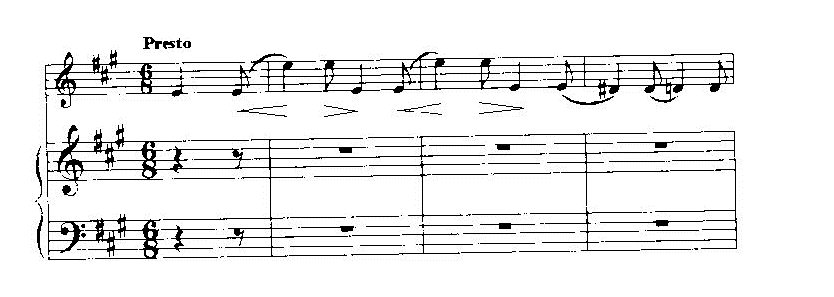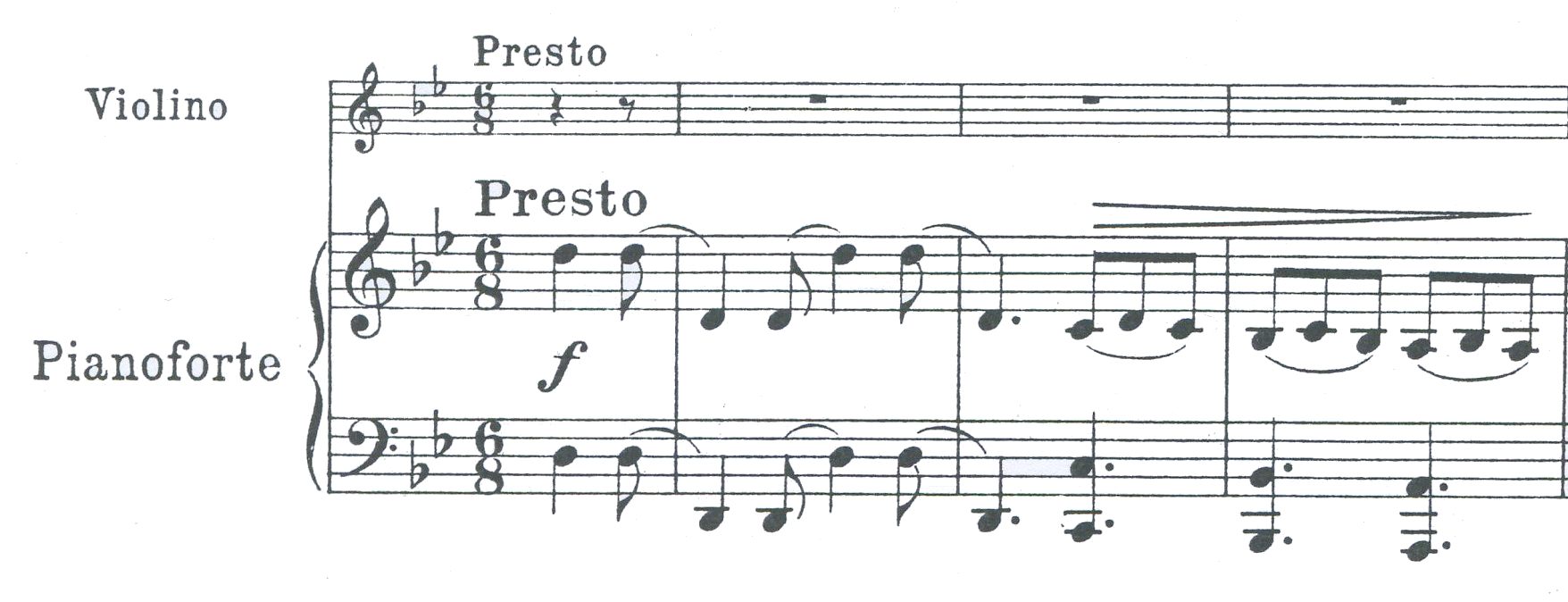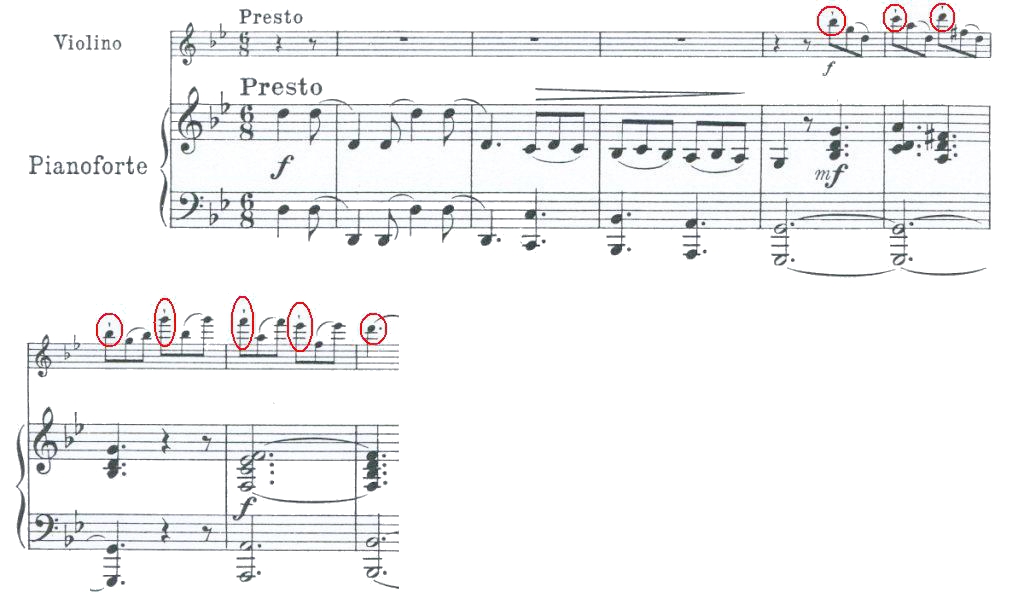Henryk Wieniawski
Scherzo-Tarantelle Op. 16
Żar i płomień!
Gdyby takich
Wieniawskich było wielu,
to by trzeba na
nich zawołać:
ostrożnie,
szaleńcy! ziemia zgorzeje!
[Fervour and flame! If these
Wieniawskis were many
We’d
have to call: careful, you madmen! The earth will catch fire!]
Józef Sikorski,
„Ruch Muzyczny” 1860 nr 25
Scherzo-Tarantella for violin and piano op. 16 – a sparkling,
glittering virtuoso miniature – was written in 1855, when Wieniawski’s violin
career and fame were approaching their peak, at a time when, after two years
spent on a concert tour of Europe with his brother, he returned to his native
Lublin to spend some time there, and then set out on further concert tours,
this time alone. Scherzo was
dedicated to Lambert Massart, a professor at the Paris Conservatory, who had
been Wieniawski’s teacher. The work belongs to the category of virtuoso
miniatures, but its character is less of a salon composition than Wieniawski’s
other miniatures, such as Capriccio-Valse
op. 7, or Romance sans paroles et Rondo
élégant op. 9. It was published in the version for solo violin with piano
accompaniment, but the composer was also planning a version for violin with orchestral
accompaniment, as evidenced by the autograph of the score; this leads to the
conclusion that he intended it to be performed at concert halls rather than
salons. The work is written with panache, and provides the soloist with an
opportunity to display his technical skills, but it also contains a lyrical,
sweet cantilena, so characteristic of Wieniawski’s work.
The title of the work combines the names of two different genres. The question arises whether the choice of Tarantella as a segment of the title, which undoubtedly points to the expressive character of the composition and brings association with the Italian folk dance, was directly inspired by Chopin’s Tarantella, or was it, perhaps indirectly, inspired by Karol Lipiński’s transcription of it? Józef Reiss seems to have no doubt on that score; in his opinion:
it seems clear that his idea was influenced by Chopin’s Tarantella, particularly as, in the transcription by Karol Lipiński, Celebre tarantelle de F. Chopin was among the most spectacular stage compositions for violinists.1
Although Reiss’s judgment was so categorical, we are still surrounded by guesses and hypotheses, since none of the extant sources confirms the claim that Wieniawski was inspired by the transcription in question. Nor does the presence of certain external similarities between the two compositions provide sufficient grounds for establishing a link between them, since these features are inherent in the tarantella genre per se. A clue, to be discussed in detail further on, suggestive of the influence of Lipiński’s transcription on Scherzo-Tarantella, might be provided by the work’s introduction; it is based on identical intervals and rhythmic and articulatory plans, while the only difference is the reversed direction of the movement of the intervals. The rhythmic similarity undoubtedly and obviously results from the characteristic rhythm of the tarantella, but the commonality of the intervals may indicate that Chopin-Lipiński’s Tarantella did provide some degree of inspiration.
Wieniawski’s composition preserves all the typical, constitutive features of a tarantella as a dance maintained in a vivacious fast tempo (Presto in Wieniawski’s work), with the characteristic uniform motion of small rhythmic values (eighths), in 0 metre. Together with the character and expression defined by the first segment of the title, Scherzo, this resulted in an original composition which combined two genres: the Italian folk dance tarantella and the scherzo. However, this is not the scherzo of Chopin or Beethoven, demonic and dramatic; it is a scherzo that is light, playful, full of brilliance and gusto.
Form
The work has the form of a rondo, built on repeated regular phrases and sentences, with the use of variation technique.

Example 1 Form schema
Józef Reiss2 claims that the composition has the traditional da capo form. In his short analysis, the author judges the Maggiore and Cantabile sections to be a formal whole; in this, he is probably guided by the similar expressive character of the two sections and the same mode of the tonalities used in them. He ignores, however, the return of the melody of the refrain between the Maggiore and Cantabile sections, which plays a very important part in creating the formal shape of the whole, as well as their obvious tonal contrast – Maggiore is in G major, while Cantabile is in D major.
The work begins with a short piano introduction, which introduces the hectic rhythm of Tarantella, recalling vividly (as has been mentioned earlier) the beginning of Tarantella by Chopin-Lipiński.

Example 2 Chopin Tarantella op. 43

Example 3 F. Chopin–K. Lipiński Tarantella op. 43

Example 4 H. Wieniawski Scherzo-Tarantella op. 16
In both in the case of Wieniawski and Lipiński we are dealing with identical rhythmic shaping and intervalics, as well as the same articulation and bowing. Wieniawski only changes the direction of octave leaps, beginning with an octave downwards, in contrast to Chopin-Lipiński. The same bowing in both works seems to come naturally, since the arrangement of the interval leaps suggests in itself such a distribution of slurs and directions of the bow. However, the commonality of intervals is another matter, since it may indicate that Wieniawski is referring to Chopin’s composition in its violin version by Lipiński.
The vivacious, fiery, motoric refrain combines in it the idiom of both genres referred to in the title. The constant motion of small rhythmic values, in this case eighth notes, and the dizzy tempo, originate from the Italian dance, while the sharp articulation and the combinations of groups of eighths and single chords which appear in the latter part of the refrain endow the whole with the lightness and playfulness of a scherzo. The form-creating force here is the variational transformation of phrases and sentences. The theme is built on triad passages, with the melodic motive, marked by expressive accents, interwoven into them.

Example 5 H. Wieniawski, Scherzo-Tarantella op. 16, introduction
(bars 1-4)
and main theme (bars 5-9) with the melodic notes marked in red
After
changing the tonality to the major one beginning with the same note (G major) we have the appearance of the
first couplet of the rondo, Maggiore,
where the composer initially allows the soloist a moment of rest, introducing
the fluid, lyrical Tranquillo cantilena,
followed by figurative eighth-note
passages combined with flageolets (a technical device very much favoured by
Wieniawski); against their background, the piano leads the melody which had
been introduced earlier by the soloist, thus becoming the melodic instrument
for a short period. Into
the course of the Maggiore section is
woven the eleven-bar Cadenza of the
soloist, based on eighth-note passages, eight bars of which, according to the
composer’s intention, are to be performed in one bow stroke. Maggiore flows smoothly into the
returning refrain which, however, is here very much changed both in terms of
melody and harmonics. This refrain functions only as a bridge between the two
cantilena sections in major tonalities (the Cantabile
which follows is in the tonality of the dominant, D major), and recalls the vivaciousness and the energy of the
tarantella. Cantabile – the second
couplet of the rondo – is a singsong section throughout; it is a cantilena filled
with a wide breath, characteristic of Wieniawski’s compositional style. After
the lyrical Cantabile the vivacious
refrain bursts forth again; truncated here, it flows smoothly into the coda
which closes the composition.
In this work, the piano takes on the part of the accompaniment, with the exception of the fragment referred to above in the Maggiore section, when it takes over leading the melody. Its texture is almost exclusively chordal. In the refrain these are mostly single short chords separated by rests, what might be described as quasi-percussion strokes which function as harmonic vertical guides and provide rhythmic stability for the part of the soloist. The piano texture undergoes changes in both the major sections. In Maggiore, initially, when the violin leads the melody, the piano creates the harmonic base; here, Wieniawski uses the repeated bourdon note d (over the space of four bars, because of harmonic changes, it becomes note e). The texture still remains chordal, but its course is no longer interrupted by rests. Further on, from the moment when the violin intones figurative motives with flageolets, the piano, while still preserving the chordal texture, takes over the melodic line which Wieniawski has intricately interwoven into the chordal course.
A clear change of texture takes place in the Cantabile section, when the piano part moves into figurations in eighth notes based on broken triads. There also appear the arpeggios which accompany the single melodic motives of the refrain, serving as a bridge between the two units into which the whole of the Cantabile section divides.
In this composition, Wieniawski does not concentrate and stack up virtuoso technical devices to be faced by the performer – instead, he operates with a few basic, repeated technical manoeuvres. It might appear that the pure, clear and transparent picture presented by the music notation does not conceal behind it any performance difficulties. However, this is a misleading impression when one takes into account the fact that the work is to be played Presto; at this tempo, even the apparently simplest eighth-note figurations on broken chords, which constitute the structure of the theme of the refrain, present the soloist with a challenge. In order to convey the expressive character of the work, the composer introduces many fragments played staccato, as well as anchored figures and chords in the coda.
The above analysis concerns the violin and piano form of the composition, the version familiar to us from Kistner’s German first printing. However, as has been mentioned at the beginning, there is an autograph of a version for violin accompanied by orchestra. It would be worthwhile to discuss briefly this surviving autograph of the score to examine the ways in which the orchestra is used. Wieniawski made use of orchestral instrumentation typical of compositions with the character of a concerto. The soloist is accompanied by flutes, oboes, clarinets, bassoons, horns, trumpets, timpani and string quintet. The longer orchestral introduction is constructed on the basis of a dialogue between a group of woodwind instruments and strings. Where the soloist plays his exhibition, virtuoso part, the orchestra is reduced to the minimal chamber cast. Thus, while in Maggiore, in the version for violin and piano, the main melody is taken up by the piano, in this score this cantilena is entrusted to the first clarinet, and then taken up by the flutes. In the first unit of Cantabile the wind instruments are omitted, and the orchestral tutti appears only at the end of the work. Wieniawski operates mainly with a reduced orchestra, a solution justified by the character of the work, which should be dominated by the solo instrument without being drowned out by the orchestra. The composer has given numerous expressive and performance markings to the parts of the orchestral instruments, which makes it easy to recognise the intended sound of the version of the work for violin and orchestra.
There are a number of transcriptions of Scherzo-Tarantella op. 16, including a version for piano and cello by the Ukrainian cellist Yuriy Leonovich3, and a transcription for solo violin and chamber ensemble (four violins and cello) by Arnold Rezler4. Scherzo-Tarantella op. l6 has also frequently served as exercise material for young composers: there are a number of transcriptions of this work for accordion (a version for accordion recorded by Jack Grekow on his CD Southern impressions), as well as a version for solo piano.
Photocopy of the autograph of the score for violin and orchestra held in the collectionof the Archive-Library of TMiHW [Henryk WieniawskiMusical Society in Poznań], there is no information of the whereabouts of the original. The photocopy in incomplete, the second page of the authograph is missing (according to the version for violin and piano those are bars 33-72). The authograph contains nine numbered pages of large, but precisely not defined, dimensions; four pages of the photocopy form one page of the authograph, each comprising all the orchestral forces: fourteen staves drawn with a raster – thirteen written on, the top one empty, except for the first page, where the call number M314 is added, probably later, in a different handwritting; in the middle of the page, above the first stave, the title Scherzo-Tarantella, a little more to the right Hri. Wieniawski op. 16. On the first stave above the first bar the tempo marking Presto, also repeated under the first bar of the last stave. Page numbers entered probably by the composer himself in the top right-hand corner. Key signatures are placed only on the first page. Composer's ornamented signature: Hri. Wieniawski appears after the bar-lines on the last page.
First printing of the version for violin and piano, published in Liepzig by the F. Kistner company in 18565, publication No. 2180. Title page (collective for the violin-piano version and violin part: Scherzo-tarantelle / POUR / Violon / Alec accompagnement de Piano / composée et dédiée / A MR. LAMBERT MASSART / Professeur de Violon au Conserzatoire Impérial de Paris, / Chevalier de l’odre de Léopold etc. etc. / par / HENRI WIENIAWSKI / Op. 16 Pr. 25 Ngr. / Propriété de l’Editeur / Enregistré aux Archives de l’Union. / LEIPZIG, FR. KISTNER. / 2180. 12 pages.
Magdalena Chylińska
Translated by Zofia Weaver, Ewa Cholewka
__________________________________________________________________________________________________






